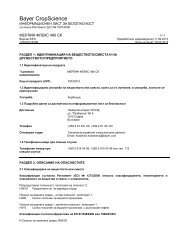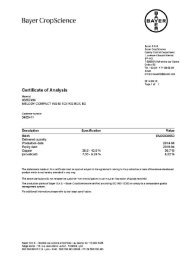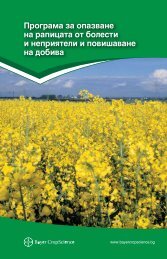Potatoes⦠- Bayer CropScience
Potatoes⦠- Bayer CropScience
Potatoes⦠- Bayer CropScience
You also want an ePaper? Increase the reach of your titles
YUMPU automatically turns print PDFs into web optimized ePapers that Google loves.
Life cycle of Phytophthora infestans<br />
Sporangia<br />
release zoospores<br />
Movement of zoospores on<br />
the leaf surface<br />
Sporangium<br />
Infected tubers<br />
as an inoculum<br />
source for primary<br />
infections<br />
Direct<br />
germination<br />
of sporangia<br />
Zoospores<br />
encyst and<br />
germinate<br />
Mycelial growth<br />
Infection of tubers<br />
via sporangia<br />
Formation of a sporangial lawn<br />
on the underside of the leaf.<br />
shade (Solanum sarrachoides) and rocket<br />
leaf (dense-thorn bitter apple Solanum<br />
sisymbriifolium), which can then act as<br />
host plants for inoculum.<br />
More action against<br />
Phytophthora necessary<br />
Keeping Phytophthora infestans under<br />
control will require more vigilance and<br />
action towards prevention and eradication<br />
than before, says Schepers. He emphasises<br />
that prevention always begins with the<br />
elimination of sources of early infection,<br />
for example by covering cull piles early on,<br />
and by removing volunteer plants. Moreover,<br />
early foci of Phytophthora infection<br />
must be suppressed as rapidly as possible.<br />
In the Netherlands, a system of presenting<br />
farmers with yellow and red cards has been<br />
in use for several years to encourage this:<br />
potato growers who do not have their<br />
cull piles covered by April 15 are given a<br />
yellow card; the same applies to growers<br />
with many volunteer plants in their fields,<br />
and to growers who do not control the<br />
early foci, or do so only inadequately. If<br />
the growers have not acted within 3 days<br />
of receiving the yellow card, the consequences<br />
are a red card and a fine.<br />
A second factor that can curb the<br />
disease is extended crop rotation. Research<br />
has shown that oospores can survive in the<br />
soil for 3 to 4 years. If a second crop of<br />
potatoes is grown within this period (or if<br />
volunteer plants are allowed to grow on<br />
the same plot of land), early infection can<br />
develop from oospores.<br />
Choice of variety is a further important<br />
factor in keeping Phytophthora in check.<br />
Infection occurs considerably less rapidly<br />
in highly-resistant varieties. With regard to<br />
crop protection, the spraying strategy must<br />
be tightened up where mixed populations<br />
are present, in order to counter the increased<br />
risk of infection. Among other<br />
things, this can mean starting spraying<br />
earlier, with shorter intervals between<br />
applications, so that the pathogen has less<br />
chance to develop. In addition, where there<br />
is high disease pressure, more attention<br />
will have to be paid to combining different<br />
active substances (modes of action) than<br />
is the case at present. Schepers draws<br />
attention to the critical issue that active<br />
substances increasingly have a limited<br />
number of applications. “With the more<br />
aggressive Phytophthora being present,<br />
greater knowledge is needed in order to<br />
develop a watertight strategy.” ■<br />
Written by: Han Hammink<br />
20 COURIER 1/08















